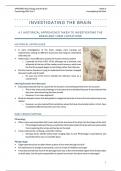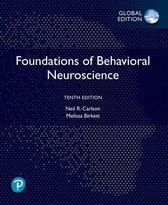4PAHPBIO Psychology and the Brain Week 4
Psychology BSc Year 1 Investigating the Brain
INVESTIGATING THE BRAIN
4.1 HISTORICAL APPROACHES TAKEN TO INVESTIGATING THE
BRAIN AND THEIR LIMITATIONS
HISTORICAL APPROACHES
• In early investigations of the brain, people were carrying out
experiments, looking at different structures and trying to understand
what they did
• Historically, it was difficult to access the human nervous system
o Leonardo da Vinci (1952-1519), although not a scientist, was
influential at the start of the modern era of science, which was
the first time people began to test things rather than theorise
• Da Vinci had an interest in trying to understand how function changed
between health and ill health
o He was one of the first to identify the olfactory nerve as a
cranial nerve
Inferring Function from Structure
• Early ideas believed that we could infer the function of something entirely from its structure
o This is why many early drawings of a structure are so detailed because it was believed that
they were also describing function as well
o However, it is a naïve approach
• Brodman helped us learn that being able to categorise the brain in terms of its microstructure is very
helpful
o However, we also learned that sometimes areas that look structurally similar, in fact, have
completely different functions and vice versa
EARLY BRAIN MAPPING
Phrenology
• Often, early neuroscientists didn’t even look at the structure of the brain, but the shape of the skull
o Phrenologists believed that you could infer information about the brain and even personality
from inspecting the lumps and bumps on the skull
• It was criticised for not being a scientific method
o Dempsy-Jones (2018) tested brain imaging data to test Phrenology’s assumptions and
found that there was no scientific basis
Phineas Gage
• Gage experienced an accident where a piece of iron went through his skull
• He experienced a change in personality, such as a loss of inhibition and anger
• It was discovered that most of the damage done was to the ventromedial region of the frontal lobes
on both sides, but the parts responsible for speech and motor functions were not damaged
1
,4PAHPBIO Psychology and the Brain Week 4
Psychology BSc Year 1 Investigating the Brain
o This change provided evidence to support the theory of localisation of brain function, as it
was believed that the frontal lobe was responsible for the control of emotion
o Supported the use of frontal lobotomies, where people would have the frontal regions of
their brains removed
• However, a lot of inferences were made from this one case study, and since his brain was not
preserved after death, there is no way of testing whether the assumptions from his case are true
o He experienced an uncontrolled injury where other unknown brain/body damage or trauma
could have occurred
• Findings of his injury were only written about by a few people, namely Harlow (namely in 1868)
Live Mapping – Wilder Penfield
• Developed a technique for stimulating the brain during surgery
• Before giving surgery for those with epilepsy, he mapped out different areas of the cortex by
electrically stimulating the outer surface of the brain, particularly the motor and sensory regions
o He repeated this and in controlled conditions (namely, 1937)
o For example, when he stimulated one area of the brain (area 3), the patient felt a tingling in
the thumb, and when another area was stimulated, the patient reported hearing music
• Brain surgery can be done whilst awake since the brain itself has no pain receptors
PSYCHOPHYSICS
• Quantitatively investigates the relationship between physical stimuli and the sensations and
perceptions they produce
o Critical in understanding our sensory systems
• Method of limits
o A stimulus feature is gradually increased until a participant is aware and then gradually
decreased until they are unaware
o The awareness point is averaged between ascending and descending trials.
• Method of constant stimuli
o A stimulus feature is varied across trials in a way that cannot be predicted by the participant
• Method of adjustment
o The participant is asked to adjust the stimulus level until it is barely detectable against the
background noise or is the same as the level of another stimulus
o The adjustment is repeated many times
• However, they are typically used alongside other methods since they do not directly measure
something within the brain and instead make inferences
4.2 THE THREE METHODS USED FOR MEASURING BRAIN
STRUCTURE (CT, MRI AND DTI)
STUDYING THE STRUCTURE OF THE LIVING HUMAN BRAIN
• Human brains can be measured non-invasively to study their anatomy
Computerised Tomography (CT)
• The patient’s head is placed in a large doughnut-shaped ring
2
, 4PAHPBIO Psychology and the Brain Week 4
Psychology BSc Year 1 Investigating the Brain
• The ring contains an X-ray tube and, directly opposite it (on the other side of the patient’s head), an
X-ray detector
• The X-ray beam passes through the patient’s head, and the detector measures the amount of
radioactivity that gets through it
o Different tissues absorb different amounts of the rays
• The beam scans the head from all angles, and a computer translates the information it receives
from the detector into pictures of the skull and its contents
• A CT scan can detect damage after a stroke
• The image (above right) shows a patient who had damaged bodily awareness and perception of
space due to a stroke
• Damage can be seen as a white spot in the lower left corner (scan 5)
• The patient lost her awareness of the left side of her body and of items located on her left
Magnetic Resonance Imaging (MRI)
• An MRI produces a more detailed and high-resolution picture than a CT
• Rather than using X-rays, it passes a very strong magnetic field through a patient’s body, causing the
nuclei of hydrogen atoms to align themselves to the magnetic
field
• When the magnetic field is removed, the atoms fall back to
their original position, emitting a radio frequency wave that is
detected by the machine and made into an image
• The atoms are present in different concentrations in different
tissues
o The MRI scanner is tuned to detect the radiation
from hydrogen atoms
o The scanner then uses the information to prepare
pictures of slices of the brain
• Although MRI scans can distinguish between regions of grey and white matter, allowing major fibre
bundles to be seen (such as the corpus callosum), small fibre bundles are not visible
Advantages of MRIs Disadvantages of MRIs
Able to diagnose conditions and monitor their The patient is required to lay very still in order to
progression produce a clear image so those with movement
conditions (e.g. Parkinson’s) may have difficulty
Can help guide brain surgery The scanner is very noisy and claustrophobic
Other types of imaging can be overlaid on an MRI Some with medical implants (e.g. cochlear
scan to aid understanding implants) may not be able to use the scanner
3





